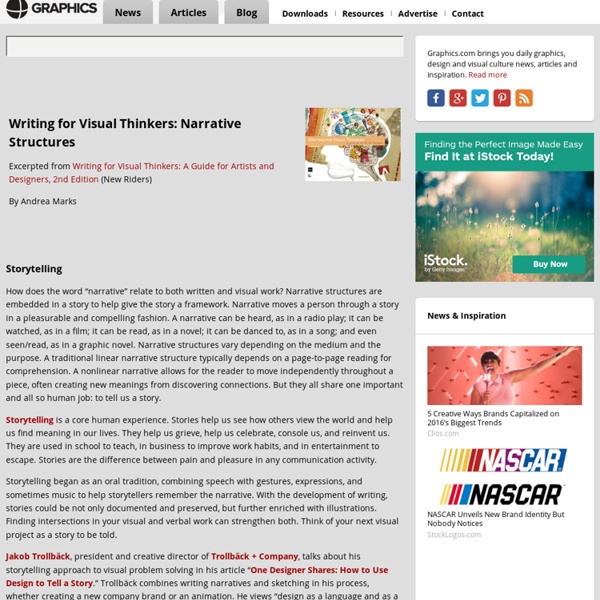



http://www.graphics.com/article-old/writing-visual-thinkers-narrative-structures
Related: Storytelling Concepts • writing stuff • ossaobHow Stories Change the Brain Ben’s dying. That’s what Ben’s father says to the camera as we see Ben play in the background. Ben is two years old and doesn’t know that a brain tumor will take his life in a matter of months. Ben’s father tells us how difficult it is to be joyful around Ben because the father knows what is coming. But in the end he resolves to find the strength to be genuinely happy for Ben’s sake, right up to Ben’s last breath.
11 Fascinating Facts About ‘Goodnight Moon’ Goodnight Moon, a deceptively simple children’s book that falls somewhere between a going-to-sleep narrative and a lullaby, will turn 68 later this year—and yet it remains one of the most universal cultural references even all these decades later. Here are a few things you might not have known about Margaret Wise Brown's sparse classic. 1. Goodnight Moon's style reflects real childhood semantics. Brown was born in 1910 to moderately wealthy but distant and bickering parents. Storytelling in the Classroom Why Storytelling? Educators have long known that the arts can contribute to student academic success and emotional well being. The ancient art of storytelling is especially well-suited for student exploration. As a folk art, storytelling is accessible to all ages and abilities. No special equipment beyond the imagination and the power of listening and speaking is needed to create artistic images.
Ep 88: How to Develop Your Own Self-Study Writing Course - Ann Kroeker, Writing Coach Podcast: Play in new window | Download (Duration: 5:00 — 4.6MB) | Embed Subscribe: Apple Podcasts | Android | RSS As you go about the work of writing, and the business of writing, don’t forget to study the craft of writing. Find ways to continually learn and improve. A lot of writers feel a strong urge to enter an MFA program to do this.
School of Education at Johns Hopkins University-In A Single Bound: A Short Primer on Comics for Educators by Drego Little There is a long and well-documented history of prejudice against comics and what educators think they might represent. Despite this history, comics have a strong following among writers and other serious artists. Sadly, this admiration for comics and their creators has not been widespread among educators. 6 Easy Steps to Unforgettable Characters By Laurence MacNaughton, @LMacNaughton Part of the How They Do It Series (Contributing Author) Readers will pick up your book because of the concept, but they’ll keep reading because of the characters.
How To Structure A Story: The 8 Point Arc By Ali Hale - 3 minute read One of my favourite “how to write” books is Nigel Watts’ Writing A Novel and Getting Published. My battered, torn and heavily-pencil-marked copy is a testament to how useful I’ve found it over the years. Although the cover appears to be on the verge of falling off altogether, I’ve risked opening the book once more to bring you Watts’ very useful “Eight-Point Story Arc” – a fool-proof, fail-safe and time-honoured way to structure a story. Thinking Through Our Fingers A picture is worth a thousand words. We’re all familiar with that idiom. As writers, our goal is to use way fewer than a thousand words to paint that perfect picture. We want those pictures to come alive for our readers. But here’s the thing, if you only paint a pretty picture, you risk leaving your readers on the outside looking in when what you really want is to lure them in.
How Visual Thinking Improves Writing Younger kids typically love to draw and aren’t too worried about the outcomes of their artwork — until they get older. By the time they’ve learned to read and write, art takes a back burner to academics, primarily because of what most schools prioritize. Over time it becomes harder for kids to think in pictures the way they once did. The Craft of Character Development Aimie K. Runyan As an author of historical fiction, my work must—almost by definition—begin with a concept. Am I going to write a gritty saga about the women who flew as combat pilots for Russia in the Second World War (I did and it was great fun)? Am I going to write a sweeping fictionalized biography of Joan of Arc?
The Golden Rules for a Good Plot Writing a novel can be a daunting task. Here are some helpful tips to ensure you write a good plot. Breaking the Rules of Writing By Janice Hardy, @Janice_Hardy This week's Refresher Friday takes another look at breaking the rules of writing. Enjoy!